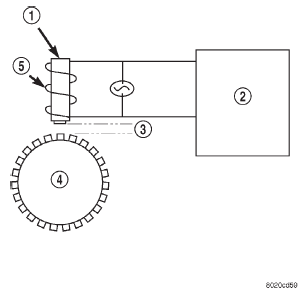 Dodge Durango Service ManualBrakes » Four wheel antilock brakes » Description and operation
Dodge Durango Service ManualBrakes » Four wheel antilock brakes » Description and operation
Wheel speed sensor
Wheel speed sensor
DESCRIPTION
The ABS brake system uses 3 wheel speed sensors.
A sensor is mounted to each front steering knuckles.
The third sensor is mounted on top of the rear axle differential housing.
OPERATION
The WSS consists of a magnet surrounded by windings from a single strand of wire. The sensor sends a small AC signal to the CAB. This signal is generated by magnetic induction. The magnetic induction is created when a toothed sensor ring (exciter ring or tone wheel) passes the stationary magnetic WSS.
When the ring gear is rotated, the exciter ring passes the tip of the WSS. As the exciter ring tooth approaches the tip of the WSS, the magnetic lines of force expand, causing the magnetic field to cut across the sensor's windings. This, in turn causes current to flow through the WSS circuit (Fig. 3) in one direction.
When the exciter ring tooth moves away from the sensor tip, the magnetic lines of force collapse cutting the winding in the opposite direction. This causes the current to flow in the opposite direction.
Every time a tooth of the exciter ring passes the tip of the WSS, an AC signal is generated. Each AC signal (positive to negative signal or sinewave) is interpreted by the CAB. It then compares the frequency of the sinewave to a time value to calculate vehicle speed. The CAB continues to monitor the frequency to determine a deceleration rate that would indicate a possible wheel-locking tendency.
The signal strength of any magnetic induction sensor is directly affected by:
- Magnetic field strength; the stronger the magnetic field, the stronger the signal
- Number of windings in the sensor; more windings provide a stronger signal
- Exciter ring speed; the faster the exciter ring/ tone wheel rotates, the stronger the signal will be
- Distance between the exciter ring teeth and WSS; the closer the WSS is to the exciter ring/tone wheel, the stronger the signal will be
The rear WSS is not adjustable. A clearance specification has been established for manufacturing tolerances.
If the clearance is not within these specifications, then either the WSS or other components may be damaged. The clearance between the WSS and the exciter ring is 0.005 - 0.050 in.
 Fig. 3 Operation of the Wheel Speed Sensor
Fig. 3 Operation of the Wheel Speed Sensor
1 - MAGNETIC CORE
2 - CAB
3 - AIR GAP
4 - EXCITER RING
5 - COIL
The assembly plant performs a "Rolls Test" on every vehicle that leaves the assembly plant. One of the test performed is a test of the WSS. To properly test the sensor, the assembly plant connects test equipment to the Data Link Connector (DLC). This connector is located to the right of the steering column and attached to the lower portion of the instrument panel (Fig. 4). The rolls test terminal is spliced to the WSS circuit. The vehicle is then driven on a set of rollers and the WSS output is monitored for proper operation.
Antilock brake system
Controller antilock brakes
Hydraulic control unit
Wheel speed sensor
Abs warning lamp
Dodge Durango Service Manual
- Lubrication and Maintenance
- Suspension
- Differential and Driveline
- Brakes
- Cooling System
- Battery
- Starting Systems
- Charging System
- Ignition System
- Instrument Panel Systems
- Audio Systems
- Horn Systems
- Speed Control System
- Turn Signal and Hazard Warning Systems
- Wiper and Washer Systems
- Lamps
- Passive Restraint Systems
- Electrically Heated Systems
- Power Distribution System
- Power Lock Systems
- Vehicle Theft/Security Systems
- Power Seat System
- Power Window Systems
- Power Mirror Systems
- Chime/Buzzer Warning Systems
- Overhead Console Systems
- Engine
- Exhaust System
- Frame and Bumpers
- Fuel System
- Steering
- Transmission and Transfer Case
- Tires and Wheels
- Body
- Heating and Air Conditioning
- Emission Control Systems
- Introduction
Categories
0.0056
